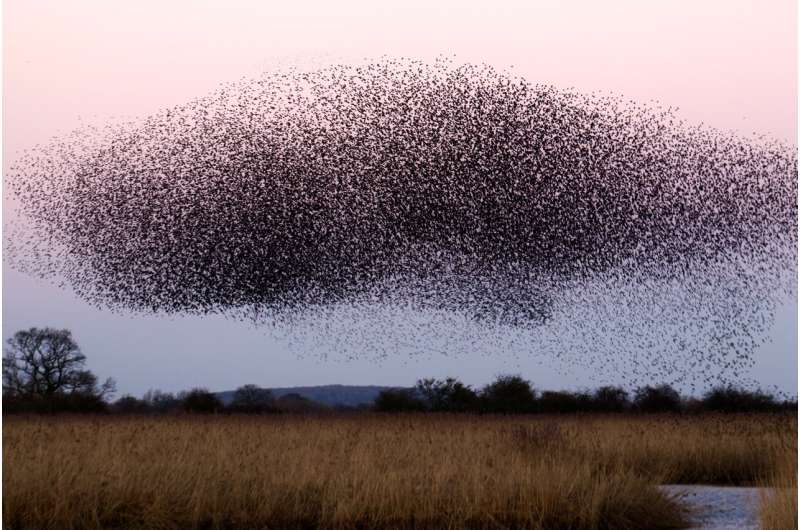For birds, flocks promise safety, especially if you're faster than your neighbor

Gaby Clark
scientific editor

Andrew Zinin
lead editor

As I walked along , just across from Galveston Island in Texas, I watched flocks of forage along the frothy wavefront as it surged and retreated. Nearby, , , and rested on the beach, .
The birds rose simultaneously as I drew near, and then settled farther down the beach, clearly fearing me.
As an and author of the new book "," I'm fascinated by how social behavior has evolved in birds. Why is it ever worth being with others that not only compete for food but may or even ?
Safety in numbers
The late Oxford University biologist William D. Hamilton discussed the advantages of flocking with his landmark 1971 paper "." He theorized that individuals in a flock stay because each benefits from the shelter of the group. At the time, a prevailing belief was that animals moved in groups for the , not the individual.
Groups provide some safety because they're harder to attack, they're more likely to provide warnings of approaching danger, and they have an ability to respond together if threatened.
But everyone in the group does not necessarily benefit equally.
The best position is one that puts another bird between oneself and a predator, making your neighbor the more likely target. This keeps birds in a group close together as each tries for . It is a kind of movement you'll also see in or great in Africa, like wildebeests.
The peril of being the lone bird
Shorebirds, similar to those I saw in Texas, might be the easiest to study, particularly where the predator can come from a forest that borders the shore.
One of the best-studied flocking shorebirds is the , Tringa tetanus, often seen on mudflats and saltmarshes in Britain. Redshanks are sandpipers very closely related to the greater and lesser yellowlegs I see in Texas, but with red legs rather than yellow.
The predator that redshanks have most reason to fear is the , which watches foraging redshanks from the trees bordering the saltmarsh. When a sparrowhawk picks its prey, it flies fast and hard toward a single predetermined target, grabbing the hapless redshank with its talons.
Evolutionary biologist studied the redshank's on the chilly and found that sparrowhawks were most successful in and those in smaller flocks.
The to a neighbor, the less likely it was to be targeted and caught. That reminds me of that old trope about how fast you have to run from a lion: just faster than your neighbor.
Large flocks have downsides, too
One downside to being in a large redshank flock is that these birds have to take more steps to get food because they have more competition.
With other flock members probing the sand, and the sand shrimp and other invertebrates fleeing this probing, the redshanks when they are in larger flocks.
Canadian ornithologist Guy Beauchamp compared closely related species on islands where there were fewer predators with those on the mainland where predators were common. , allowing the birds to forage with less competition.
Fantastic flying flocks
Flying in flocks can also help birds avoid predators.
Evolutionary biologist and his colleagues separated the behavior of predator and prey by using an artificial predator, the ingeniously engineered flying robot falcon. Its behavior could be mechanically controlled as it approached a flock of homing pigeons, all labeled with GPS tags that allowed precise measurements of how the birds' positions changed.
The team compared pigeon flight with and without attacks by the robot falcon and found that when the pigeons noticed the robot falcon, they turned sharply away from it, was turning and did not cluster more tightly.
More spectacular but harder to study are the mesmerizing flocks of as they circle and swerve, avoiding predators before settling for the night. These flocks of thousands are called and are , and likely frustrating for predators that would from the swirling scene.
Italian physicist figured out that this magnificent visual concert was the result of birds simply keeping track of , turning and moving when they did.
Beyond flocks: Roosts and supersociality
Birds are , too.
Some sleep together in roosts, nest near each other in colonies, or show off together, carrying out mating dances in what is to attract females. They may in rearing the young, typically if they are related to the breeders, or anticipate inheriting the breeding position or territory.
Take time to watch the behavior of the birds around you, and you'll start to notice social behaviors everywhere, from the ducks in a city pond to the chickadees hunting for insects deep in winter. I hope you'll watch them with more understanding of their social lives, and with a little bit more wonder.
Provided by The Conversation
This article is republished from under a Creative Commons license. Read the .![]()


















